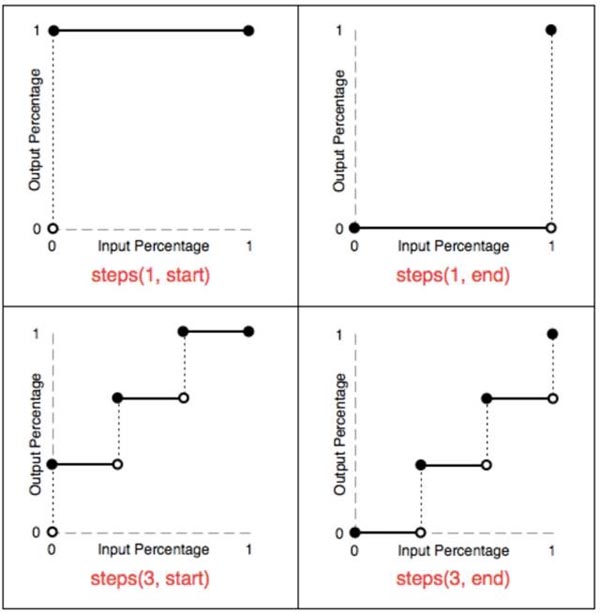这篇文章主要介绍“CSS3动画的详细介绍”,在日常操作中,相信很多人在CSS3动画的详细介绍问题上存在疑惑,小编查阅了各式资料,整理出简单好用的操作方法,希望对大家解答”CSS3动画的详细介绍”的疑惑有所帮助!接下来,请跟着小编一起来学习吧!
css3动画分类:
补间动画 – 具有连贯性的动画
逐帧动画 – 使用steps过渡方式实现跳跃
animation常用属性及场景:
animation: name duration timing-function delay iteration-count direction;1. timing-function属性:
ease 规定慢速开始,然后变快,然后慢速结束的过渡效果。
ease-in 规定以慢速开始的过渡效果。
ease-out 规定以慢速结束的过渡效果。
ease-in-out 规定以慢速开始和结束的过渡效果。
linear 动画从头到尾的速度是相同的。
cubic-bezier(n,n,n,n) 在cubic-bezier函数中自己的值,n取值为0~1
steps()
2. delay属性:
用于将动画与其他动画的执行时机错开,将动画落到不同的时间点。这个属性很好用~
动画原则:
运动一般有个惯性,所以要先快后有一个慢一点的反弹。
背景若使用多个星星闪烁,错位闪烁
配合JS使用
slide.addEventListener("webkitAnimationEnd", function() { console.log('eeee') //动画结束再调用 });有些情况我们需要确保动画结束后再进行另外一些交互,可使用该事件监听。
实战演习:
假如我们需要实现一个这样简单的动画:

仔细观察上面的动画,我们发现,它可以由以下3部分组成:
1. 入场动画——从右往左移动
2. 左右循环移动
3. 逐帧动画
实现方法:
使用3个dom元素,最外层dom实现入场动画,第二层dom实现左右移动,第三层dom实现逐帧动画。
优点:调试方便,节省时间。
缺点:dom多。
1. dom结构
<div class="anima_entrance"> <div class="anima_move"> <div class="anima_sprite"></div> </div> </div>2. 分析动画形成的时间轴:

入场动画持续0.6s,只播放一次,左右移动以及逐帧动画持续2s,循环播放,代码如下:
.anima_entrance { animation: anima_entrance .6s ease-in-out both; } .anima_move { animation: anima_move 2s linear .6s infinite both; } .anima_sprite { animation: anima_sprite 2s step-end .6s infinite both; }3. 使用steps()实现逐帧动画:
使用下面这张雪碧图,通过改变background-position实现动画切换。

蹬蹬蹬,效果如下面所示,是不是很失望?

原因:由于animation默认以ease方式过渡,它会在每个关键帧之间插入补间动画,所以动画效果是连贯性的。此时可以使用steps()取消补间动画。
贴一个图:

steps(1,start): 动画一开始就跳到 100% 直到这一帧(不是整个周期)结束 == step-start
steps(1,end): 保持 0% 的样式直到这一帧(不是整个周期)结束 == step-end
接着,我们将timing-function改成 step-end,效果如下:
animation: sprite 2s step-end .6s infinite both;
出现想要的效果了哈~不错。
完整的css代码如下:
.anima_entrance { position: absolute; z-index: 3; top: 5.1rem; left: 4.05rem; width: 12.9rem; height: 19.1rem; -webkit-animation: anima_entrance .6s ease-in-out both; animation: anima_entrance .6s ease-in-out both; } .anima_move { width: 218px; height: 382px; position: absolute; z-index: 1; top: 0; left: 42px; -webkit-animation: anima_move 2s linear .6s infinite both; animation: anima_move 2s linear .6s infinite both; } .anima_sprite { width: 218px; height: 382px; background: url(demo.png) no-repeat 0 0; background-size: 25.8rem 19.1rem; -webkit-animation: anima_sprite 2s step-end .6s infinite both; animation: anima_sprite 2s step-end .6s infinite both; } @keyframes anima_entrance { 0% { -webkit-transform: translate3d(18.75rem, 0, 0); transform: translate3d(18.75rem, 0, 0); } 100% { -webkit-transform: translate3d(0, 0, 0); transform: translate3d(0, 0, 0); } } @keyframes anima_move { 0%, 16%, 42%, 74%, 100% { -webkit-transform: translate3d(0, 0, 0); transform: translate3d(0, 0, 0); } 29% { -webkit-transform: translate3d(-1rem, 0, 0); transform: translate3d(-1rem, 0, 0); } 87% { -webkit-transform: translate3d(1rem, 0, 0); transform: translate3d(1rem, 0, 0); } } @keyframes anima_sprite { 0%, 16%, 42%, 58%, 74%, 100% { background-position: -12.9rem 0; } 8%, 50%, 66% { background-position: 0 0; } }到此,关于“CSS3动画的详细介绍”的学习就结束了,希望能够解决大家的疑惑。理论与实践的搭配能更好的帮助大家学习,快去试试吧!若想继续学习更多相关知识,请继续关注亿速云网站,小编会继续努力为大家带来更多实用的文章!
亿速云「云服务器」,即开即用、新一代英特尔至强铂金CPU、三副本存储NVMe SSD云盘,价格低至29元/月。点击查看>>
免责声明:本站发布的内容(图片、视频和文字)以原创、转载和分享为主,文章观点不代表本网站立场,如果涉及侵权请联系站长邮箱:is@yisu.com进行举报,并提供相关证据,一经查实,将立刻删除涉嫌侵权内容。
原文链接:http://mp.weixin.qq.com/s/sKcB-bh40naXJ_OJmi1qmg